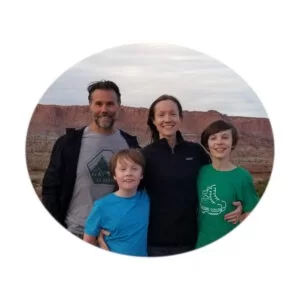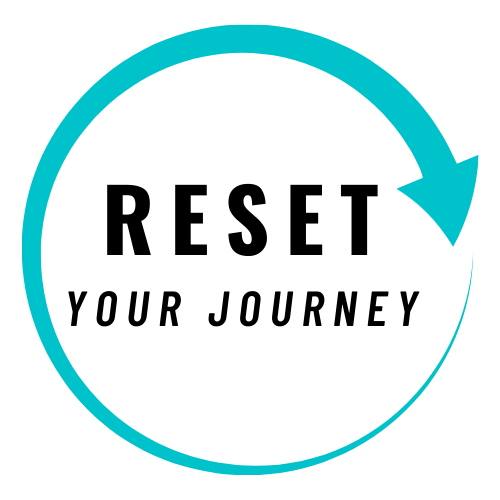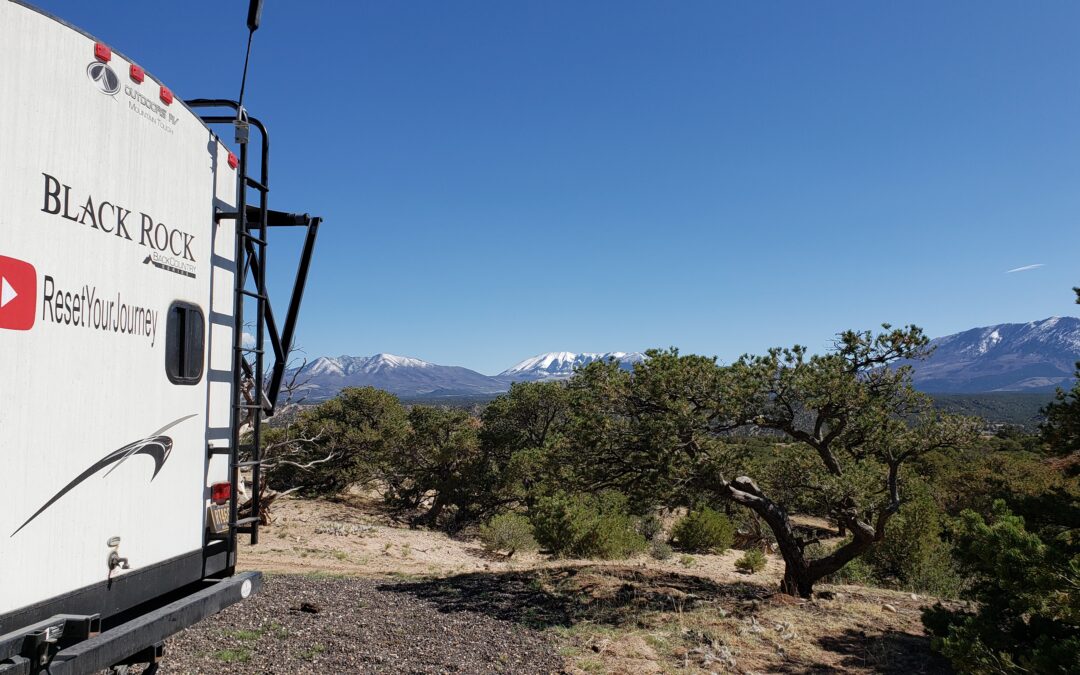Last Updated on 04/16/2024 by Glynn Willard
Whether you want to boondock in parking lots, state parks or remote areas, there are a few skills that you should familiarize yourself with first.
This is not a guide to find the best places to boondock, but an introduction to what you need to know about dry camping/boondocking.
Once you’re comfortable with the idea of boondocking, you can use our guide to our favorite camping areas to find great locations.
Let’s explore what you need to know about dispersed camping.
RV Boondocking For Beginners (Our Videos)
You’ve Heard The Term Boondocking, But What Do You Really Need To Know?
First of all, what is boondocking and how do you boondock?
Boondocking is simply using your rig without hook-ups. In other words, your rig is self-contained. It’s also known as dry camping.
You supply your own power source, water source, grey water tanks and black water tanks.
So, what’s dispersed camping?
Dispersed camping is generally thought of as using government lands such as BLM land and National Forest on which to boondock. In other words, public lands.
Truck stops, parking lots, rest areas and driveways do not fit into the dispersed camping category, but they can be boondocking locations.
Think of those beautiful pictures with an RV sitting out in the middle of nowhere by a lake at the base of a mountain and it’s still functioning. That’s dispersed camping.
Well, that’s our preferred method of living. And once you have mastered the skill set of finding land to boondock on, you may never look at an RV park again. I can’t (except to dump and fill fresh water as a last resort).
I learned most of what I’m discussing here through trial and error (by doing).
There are a lot of different ways to boondock. The goal is to find a great way that works for you!
We caught our first boondocking experience in Sedona, AZ in this video.
Download our free guide to boondocking.
What Do You Need To Boondock In An RV?
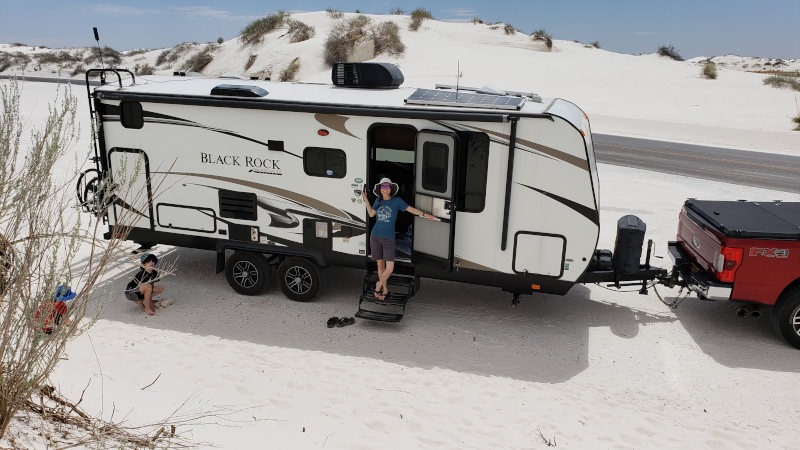
340 watts of solar keep our batteries charged.
If you’re going to boondock, your rig needs to have a way to run the systems as a self-contained unit.
- First, you need a way to power your travel trailers systems (any RV).
At the least, you need batteries and a way to charge your batteries. That can be in the form of solar panels or a generator. I find we need both.If you want to run your outlets, you need an inverter that converts DC to AC. Or you need a generator that has a built-in inverter.
We use two Yamaha generators run in parallel to produce a 30 Amp output. Here’s an affiliate image to help you know what I’m talking about:
Most rigs don’t leave the factory well set up to boondock for long periods of time. Some of the lower-end lines state they are good for boondocking, but I disagree.So, you may have to make an investment. Although, I’m starting to see a trend toward “boondock-ready” rigs from higher-end manufacturers.
Especially overland rigs.
We were fortunate to find a travel trailer that was built just for boondocking. But I would still like to add more solar power, batteries and an inverter for the house batteries.
Regardless, it works for now.
- Second, you need a fresh water tank. The water supply to your fresh tank can come from home, a campground or even a dump station.
Most RV’s have small freshwater tanks.We find that our family of four can go 10 days on 115 gallons of water.
And we really put a lot of effort into our water conservation practices.
I believe that excess water use is what ends a great boondocking trip early. This is of course remedied by using less water
- Third, you need a way to store your waste.
This means shower and sink water needs to be stored in the gray tank.And flushed toilet water needs to be stored in the black tank.
A composting toilet is also an option to replace the black tank.
- Fourth, if you work from the road, you need to have good cell service and a way to capture the data signal.
You can learn more in our article: Best Off Grid Options To Get Internet (Nomad Ways) - And finally, fifth, you need a way to store your trash.
We throw our trash out at gas stations where we fuel up, at Walmarts and at dump stations.
You can read our idea of the best boondocking RV in my article: Best Features For Off-Grid Camper (Trailers): Boondocking.
Tips To Conserve Resources When Boondocking
There are several ways to minimize your water consumption and power consupmtion:
- Trickle your water when washing your hands or dishes.
- Take Navy showers, i.e., get wet, turn the water off, soap up and then turn the water back on to rinse quickly.
- Take a shower every other day or every third day. We use wipes on the “hot spots” on non-shower days. It’s not as bad as you think.
- Catch your shower and sink water in a bin to extinguish your fires or toss if a biodegradable soap is used.
- Use your outdoor shower for showers, hand washing or dishwashing to save space in the grey tank.
- Keep all electrical items unplugged or off when not in use.
- If you have an inverter for the batteries, only turn it on when you need AC power. It uses electricity too.
Our take on boondocking
As I mentioned previously, now that I know how to find places to boondock, dumps and water, there’s no turning back.
More on that in a moment.
Especially out west.
Why would I pay a lot of money per night to be close to a neighbor when I can have an acre of space with views for free?
I’m okay with the work required to find sites. One way to look at it is the work is all up-front.
Once you build a list of locations, it gets easier to build a circuit of great places to boondock.
There are so many great boondocking locations all over the West. Seriously, there’s no shortage.
Yes, popular areas can get busy and they seem overrun with too many campers during peak camping season.
But there’s always a turnover of campers coming and going. So it really comes down to timing.
It’s important to have a backup plan (or several) for potential free camping spots.
This planning should always be done in advance.
Issues with boondocking
Personally, I have nothing negative to write about boondocking. But, again your rig has to be self-contained and capable of generating power.
Yes, you can do the van life and cook outside and carry portable water. That’s awesome, but not appealing for a family of four.
Especially a full time family of four. It’s one thing if you’re on a short boondocking adventure, but not for fulltime RV living.
We can microwave meals, flush a toilet, take a shower, store over a week’s worth of food, run our air conditioner, sleep in a comfortable bed and store ten days’ worth of water.
Some might say that’s not camping. I agree, it’s not. But again, we RV full-time, so why not turn some of the best spots into our backyard?
Get the idea? Although this comes at a cost. I’ll go over what we’ve found to be necessities below.
What do I like about boondocking?
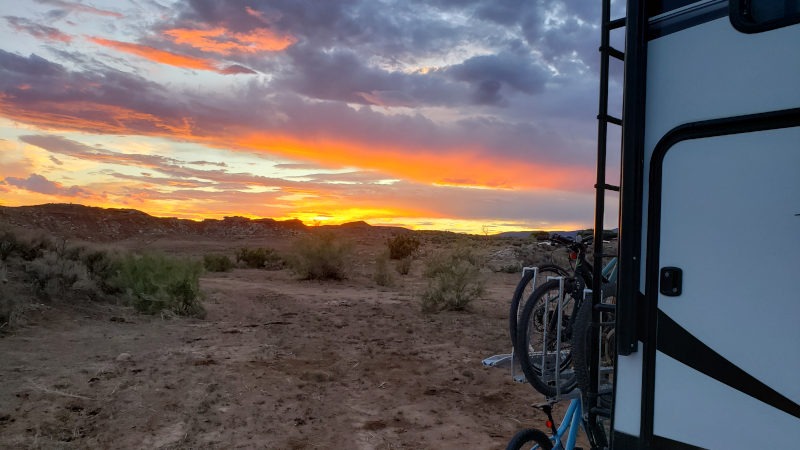
We love the beautiful sunsets visible from our boondocking locations (Utah sunset).
I genuinely feel like I’m in control of my surroundings when boondocking in a remote location. It feels REALLY free!
And speaking of free, it’s usually free. Yeah, that doesn’t hurt!
We’re not sandwiched in with neighbors. And if we don’t like it, we can move. Nothing lost.
When there are others nearby, I still feel like we have an acre to ourselves.
I also like managing the systems built for boondocking. Such as solar, the battery bank, water, etc. Conserving does not feel like skimping to me.
I like meeting other like-minded campers who share the same values. We’ve made some genuine friends dispersed camping.
We like feeling like we can stay for a while or leave whenever. There’s no schedule.
Too windy to drive? No big deal. You’re boondocking and can wait to leave when it’s safe.
Most National Forests and Bureau of Land Management lands have (approximately) a fourteen-day limit. We tend to max out in one place for ten days.
Rose and I both like that so many of the locations are as beautiful as many of the national parks.
We also like having a smaller impact on resources since we don’t use much power. That goes back to conserving.
Not Sure What You Need For Your RV?
How Do You Find Great Boondocking Spots?
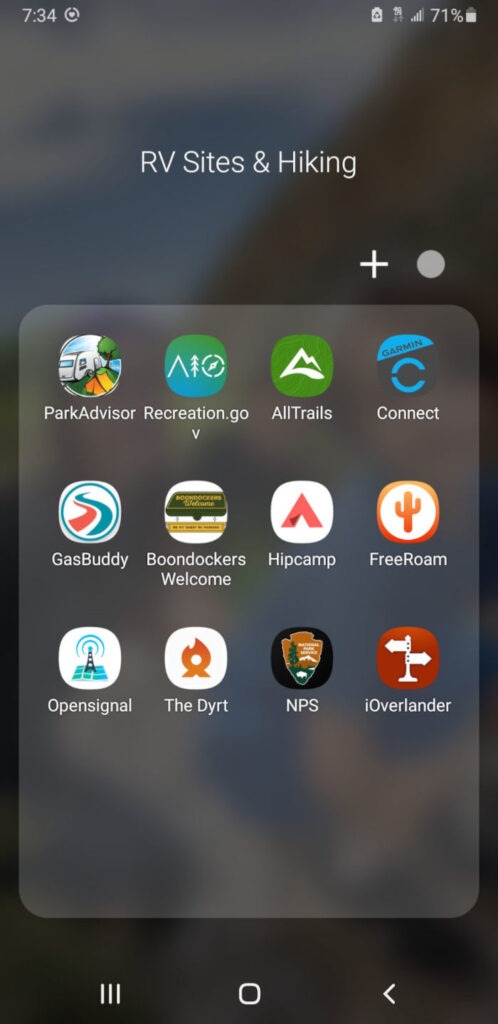
My arsenal of apps to find camping, water, dump, diesel and cell signal.
The easiest way to find boondocking spots is with the different apps available.
This might be intimidating, especially if you’ve never dispersed camped before.
There are a lot of apps to choose from. Campendium, ioverlander, Google maps, freeroam.app, etc. This list grows by the week.
Regardless, I like to use freeroam.app and iOverlander combined with Google Maps.
I outline the best apps to use to find boondocking locations in my article: 9 Best Apps For Boondocking And Free Dispersed Camping.
Here’s the breakdown for finding free boondocking locations:
- I look forward a few weeks in our area and find options within 200 miles on freeroam.app and iOverlander.com.
- Next, I layer on cell reception. That doesn’t always work in our favor. Starlink has changed this for many boondockers, but it’s not an end all.
- Then I select the best option for plan A, followed by plan B and C.
- Next, I find the locations on Google Maps in satellite mode.
- I make sure the sites look like they can handle a total of 50′ trailer and tow vehicle combo.
- Finally, I add them to a list to decide on when we’re ready to move. I always prepare an option A, B and C close to one another in case the first option is unsuitable or full.
That’s the basic low down on how I find wild camping sites.
Another way is by speaking with other boondockers and getting their suggestions and input.
You can also acquire digital government maps for USFS land and BLM land that will show many of the locations. I find these more complicated than necessary and they’re not free.
Start with free. You’ll get the hang of finding locations with a little practice.
Necessitates for boondocking
There are a few things that you really need to enjoy boondocking in an RV. You don’t need a $20k solar and battery setup to get by. It sure would be nice though!
But you do need:
- A decent amount of water storage. We average 10 gallons a day for a family of four.
- A storage vessel for your “personal excrement.”
- Enough battery power to run the DC systems in your rig for 1-3 days.
- A way to recharge those batteries in good or bad weather. That’s solar and a generator.
- A way to heat your rig in cold weather. Propane is the typical solution. It also runs the fridge if you avoid a residential fridge. Looking forward, a DC fridge is the best option.
- Finally, you need a good set of tools to do self-repairs when you’re away from civilization.
We’ve compiled a list of boondocking essentials to help you save time when deciding between the stuff that will weigh you down and what is really helpful to have when dispersed camping.
It’s on our Essential Boondocking Gear page.
How Do You Find Water When Boondocking?
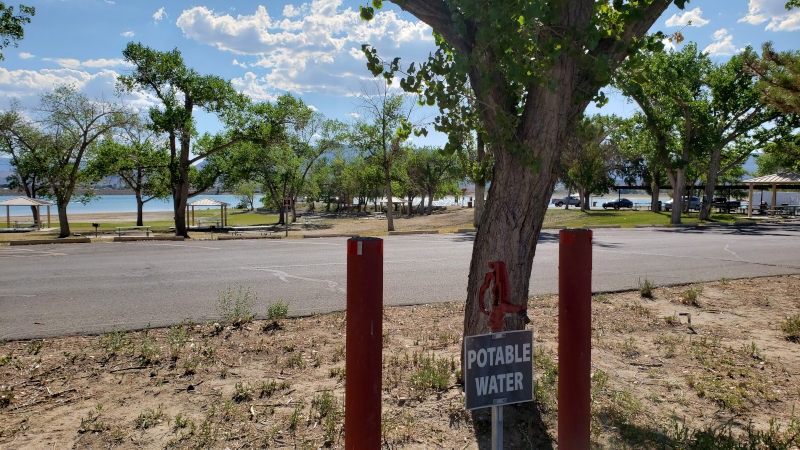
This is a state park, so I trust the sign despite the red handle.
Originally, this was the toughest thing to find. Especially in the desert. We used Boondockers Welcome or Harvest Hosts to fill our tanks the first time we got started dry camping.
Then we became more familiar with finding water elsewhere.
Now, I use freeroam.app, iOverlander.com and sanidumps.com to find water. A lot of the more recent reviews mention if water is available.
If all else fails, we call RV parks in our area to ask the price to fill water and dump tanks.
Most will allow you to do that for a fee. If it’s inexpensive, we swing by and return to dispersed camping. If it’s expensive and the only convenient option. We book a night and take advantage of the sewer hookups, extra power and water.
At least we can take a longer hot shower and, if it’s time, sanitize our fresh tank.
How Do You Find Dump Stations?
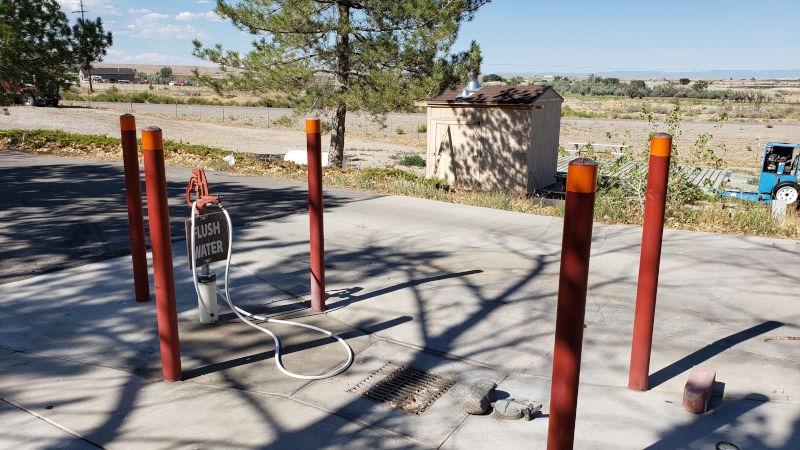
A dump site with a clean out hose is a welcoming experience.
Again, freeroam.app and sanidumps.com are great resources.
Most of the Western United States make them available for free because of the popularity of RVing.
Also, many of the gas stations in the West offer it for free or for a small fee. If I’m using a gas station’s dump, I always purchase diesel from them as a thank you.
It gets easier to find dump stations the longer you’re on the road.
I make it a general rule to find everything I need on the way or close to our next dispersed camping location.
In other words, I have a plan. It really reduces any anxiety about boondocking.
Boondocking Do’s and Don’ts
When you’re boondocking, there are a few understood rules.
Do:
- Pack out your trash.
- Be friendly to neighbors.
- Minimize your noise (generators, etc.). Our Yamaha generators are very quiet and we only run them mid-morning and late afternoon for a total of 30-60 minutes.
- Police the area and remove any trash that’s not yours. We all need to chip in.
Please Don’t:
- Stay for more than fourteen days (unless you’re in an extended stay area).
- Leave trash in the fire ring.
- Annoy your neighbor if they appear to want to be left alone
- Run your generators super early or late. Or all day for that matter.
- Dump your black tank anywhere except for a designated dump station.
- Dump your grey water unless you have it confirmed that it’s allowed. It is okay to catch hand washing and shower water to extinguish campfires.
- I’m sure I’ve left some out. But, simply, don’t be a butt-head.
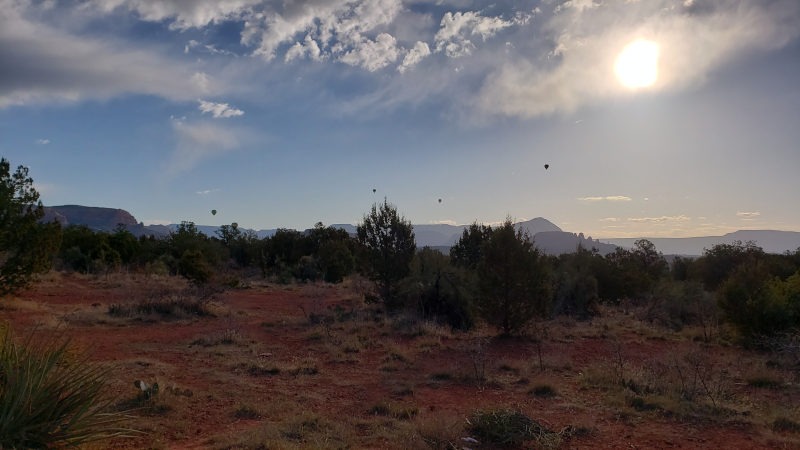
A morning view from our first true boondocking location.
Is boondocking dangerous?
I haven’t experienced anything that would make me uncomfortable. The few “sketchy” individuals I came across, actually had great stories.
I always offer anyone who fits that criteria some water and I make a friend.
Water is like gold when you’re dispersed camping.
You can also get a vibe of those who want to be left alone. Respect that situation and all is well.
Worst case scenario, you feel really uncomfortable or get a bad gut feeling, you move to plan B. That simple.
You do need to be aware of the local wild animals. That means not leaving food or trash outside your rig for any period of time. Especially overnight.
We seal up our trash and store in our truck bed, which has a Diamondback hardcover.
Also, when in the desert, check the ground under your steps for rattlesnakes. On one occasion, I found several under our rig in the early evening.
Be aware of your surroundings and you’ll be just fine in your favorite boondocking sites.
You can read more in our article: Is Boondocking Safe? Our Scariest Experiences Boondocking.
My families thoughts on boondocking
They love it! The kids have room to run and play and we can spread out and enjoy the beautiful scenery.
And that about sums it up!
A Great Resource For Boondocking
When I started, I found boobdockersbible.com. They have a fantastic, no BS site with good information and they’re good people.
Their site will be a helpful asset in mastering boondocking.
Have you found boondocking to be better than campgrounds?
Meet the author.
We appreciate any help to bring you great content. Donate or buy us a coffee on our Ko-Fi site. Or subscribe to our YouTube Channel. Thank you so much for being here!
